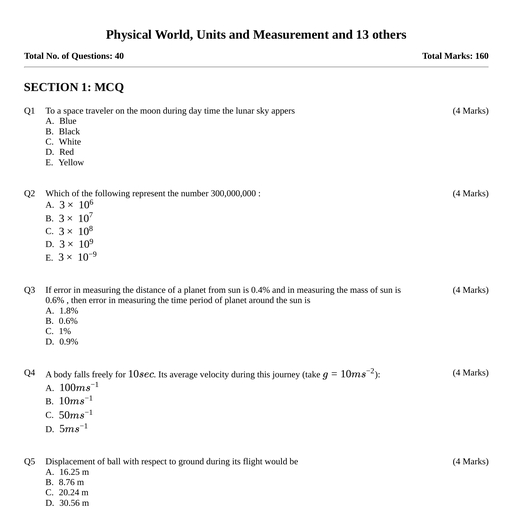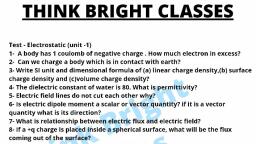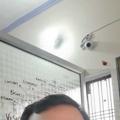Question 1 :
A charge is kept at the centre of a shell. Shell has charge Q uniformally distibuted over its surface and radius R. The force on the central charge due to the shell is :
Question 2 :
<span class="wysiwyg-font-size-small"><span class="wysiwyg-font-size-small"><p class="wysiwyg-text-align-left">Fill in the blank.</p><p class="wysiwyg-text-align-left">$1$ Coulomb of charge contains_______number of electrons.</p>
Question 4 :
<span class="wysiwyg-font-size-small"><span class="wysiwyg-font-size-small"><p class="wysiwyg-text-align-left">A charge q is enclosed in a cube at its geometrical centre. What is the electric flux associated with one of the faces of cube:</p>
Question 6 :
A charged particle is accelerated by a potential of 200V. If its velocity is $8.4\times 10^8m/s$, then value of e/m for that particle in $C/kg$  is:
Question 8 :
Electric field of a dipole is related to distance $r$ as
Question 9 :
What happens when two straws are individually rubbed with separate sheets of paper and are brought near to each other?
Question 10 :
An electric dipole placed with its axis in the direction of a uniform electric field experiences:
Question 11 :
If two charges of $1$ coulomb each are placed $1\ km$ apart in vacuum, the force between them will be:
Question 12 :
A charge q is placed at the centre of the line joining two equal charges Q. The system of the three charges will be in equilibrium if q is equal to :<br/>
Question 13 :
The force between two charges $2\mu C$ and $4\mu C$ is $24 N$, when they are separated by a certain distance in free space. The forces if, $(a)$ distance between them is doubled and $(b)$ distance is halved are :
Question 14 :
Two small identical spheres having charges $+10\mu C$ and $- 90\mu C$ attract each other with a force of $F$ Newton. If they are Kept in contact and then separated by the same distance, The new force between them is:
Question 15 :
If a mass of $20\ g$ having charge $3.0\ mC$ moving with velocity $20\ ms^{-1}$ enters a region of electric field of $80\ NC^{-1}$ in the same direction as the velocity of mass, then the velocity of mass after $3s$ in the region will be
Question 16 :
The electric field at a point $2$cm from an infinite line charge of linear charge density $10^{-7}$ $cm^{-1}$ is?
Question 17 :
A long cylindrical wire carries a linear charge density of $3\times 10^{-8} Cm^{-1}$. An electron revolve around it in a circular path under the influence of the attractive force. $KE$ of the electron is :
Question 18 :
Two infinitely long parallel conducting plates having surface charge densities$\displaystyle +\sigma$ and$\displaystyle -\sigma$respectively, are separated by a small distance. The medium between the plates is vacuum. If$\displaystyle { \varepsilon }_{ 0 }$is the dielectric permittivity of vacuum then the electric field in the region between the plates is:
Question 19 :
Two parallel large thin metal sheets have equalsurface charge densities$\displaystyle \left( \sigma =26.4\times { 10 }^{ -12 }{ c }/{ { m }^{ 2 } } \right)$ of opposite signs.<br>The electric field between these sheets is:<br><br>
Question 20 :
Charges $Q_1$ and $Q_2$ are placed inside and outside respectively of an uncharged conducting shell. Their seperation is r.













































